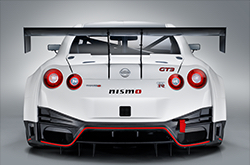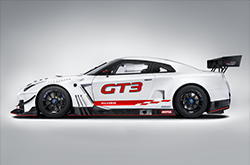


As the Nissan GT-R is based on the concept of "pursuing the ultimate driving pleasure," it is inseparable from motor sports. By competing in prestigious international competitions, the refined technology and driving presence of the Nissan GT-R has continued to evolve.
The NISSAN GT-R NISMO GT3, a racing car developed based on the regulations of the FIA GT3, is also a successor of the Nissan GT-R legacy. Since its launch in 2012, the NISMO GT3 has competed in GT3 races in which numerous global manufacturers compete for the victory. It has continued to refine its competitive performance.
It won the overall victory at the "Bathurst 12 Hour," a race held at a special course made of enclosed public roads in Australia in 2015. It also raced in the "SUPER GT Series" GT300 class that was held in Japan, in which GT cars from various manufacturers displayed a heated battle between rivals. The car won 1st and 2nd for two consecutive races of both the Fuji Round and Thai Round, proving its high competitive performance.
In addition, it won the championship at the Blancpain Endurance, the largest GT3 championship in Europe.
In 2016, it won in all six races for the "Super Endurance Series," easily winning the series championship. At the "Total 24 Hours of Spa," one of the top three global 24 hour races, the car finished all the races consecutively 4 years in a row between 2014 and 2017, as well as finishing "24 Hours Nurburgring" consecutively between 2014 and 2016, proving its durability and reliability.
The technology and experience accumulated and refined during these severe competitions were inherited for the evolution of the next generation NISMO GT3.
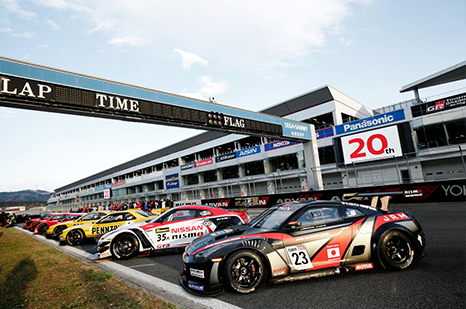


The major theme of the NISSAN GT-R NISMO GT3 2018-Spec is to improve driving performance by lowering the gravity center and optimizing the front and rear weight distribution.
The position of the engine used to be the same as that of the GT-R. It is now lowered approximately 150 mm by making the oil pan thin by implementing a dry sump system. By lowering the entire power train that includes components such as the propeller shaft and gear box which are heavy, the center of gravity was significantly lowered successfully.
In order to optimize the front-and-rear weight distribution, the engine was moved backward, approximately 150 mm closer to the vehicle center. Thus, the weight distribution was optimized.
Furthermore, the torsional rigidity of the front end was increased and the suspension was fully reviewed. With its low center of gravity and optimum weight distribution, a maneuverability that responds accurately to the driver's input is achieved.
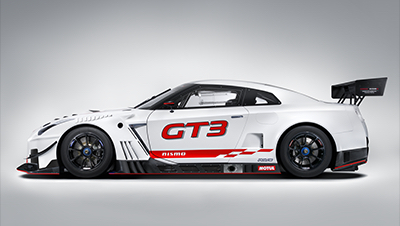
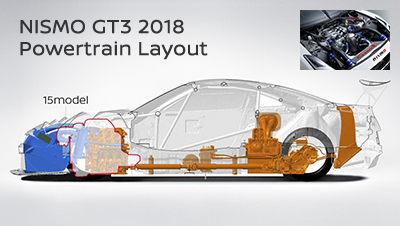
Compared to the 2015 model, the engine and power train are placed lower. In addition,
by moving the engine to the back, the front-and-rear weight balance is optimized.

The aerodynamics of the NISSAN GT-R NISMO GT3 2018-Spec isdeveloped to ensure vehicle stability and to improve the cooling performance.
By reviewing the suspension settings thoroughly, the vehicle position change is controlled. Stable down force that is not affected by the change in vehicle height due to suspension setting changes at the circuit is ensured.
Furthermore, air flow inside the engine room is optimized to increase down force. Driving stability in the high speed range is improved.
In addition, the layout of the radiator and the intercooler was modified. A space in the front of the engine room created by moving the engine to the back was used to install the radiator and intercooler at ideal positions so that air can be passed through smoothly. At the same time, the layout of air intake and air outlet was also modified to significantly improve the cooling performance.
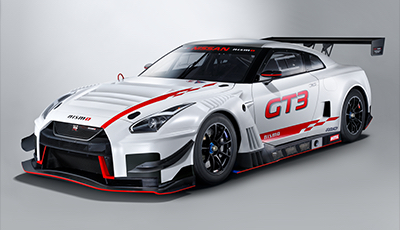
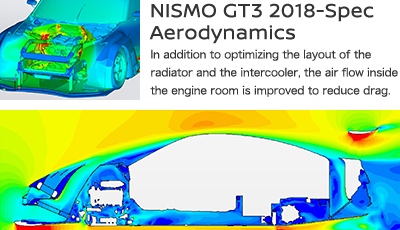

The NISSAN GT-R NISMO GT3 2018-Spec has an entirely new cockpit to improve comfortability and operability. The seat is lowered while maintaining the frontal visibility. This also helps lower the center of gravity of the vehicle.
Additionally, an innovative driver cooling system can optionally be equipped. This system does not cool the inside of the cockpit. It rather sends cool air directly to the helmet and seat to keep drivers at their best condition.
Furthermore, the steering wheel is also redesigned and the switch panel layout on the center console has been renewed. Operability is also improved.
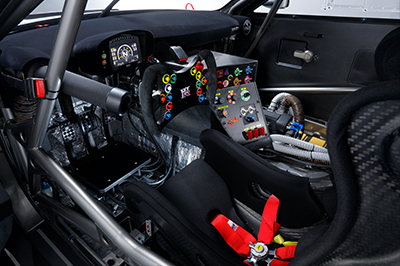
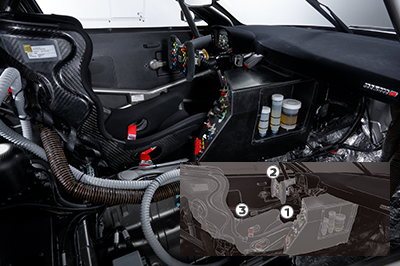
① Improved switch layout. Easier-to-use center console ②Steering wheel with improved operability ③The seat is lowered to help lower the center of gravity without hindering the frontal visibility.

| DIMENSIONS | Engine model | VR38DETT |
|---|---|---|
| Displacement | 3,799cc | |
| Power | Over 405kw/6,500rpm(Over 550ps/6,500rpm) * | |
| Torque | Over 637N・m/5,000rpm(Over 65.0kgf・m/5,000rpm) * | |
| Length | 4,832mm | |
| Width | 2,036mm | |
| Wheelbase | 2,817mm | |
| Front track | 1,690mm | |
| Rear track | 1,700mm | |
| Weight | 1,285kg * | |
| Drive system | 2WD(FR) |
| POWER TRAIN | Clutch disc | Metal, 5.5-inch 4-plate |
|---|---|---|
| Transmission | 6-speed sequential |
| BRAKE | Fr | 6-piston caliper/ |
|---|---|---|
| Ventilated Disc Brake&Pad | ||
| Rr | 4-piston caliper/ | |
| Ventilated Disc Brake&Pad |
| SUSPENSION | Fr | Double Wishbone |
|---|---|---|
| Rr | Double Wishbone |
| TIRES | Fr | 330/710-18 |
|---|---|---|
| Rr | 330/710-18 |
| WHEELS | Fr | 13.0J×18 |
|---|---|---|
| Rr | 13.0J×18 |
FIA Homologation No.:GT3-048?NISSAN GT-R NISMO GT3 2018
* Varies based on the BoP (Balance of Performance) decided by the organizers.

As a NISSAN GT-R NISMO GT3 development driver, I drove at Nurburgring as well as at circuits in Japan to develop the car. First, let me tell you what has changed for 2018-Spec.This is what I found out at the course in Nurburgring.
Stability at a high speed corner is greatly improved. Even at a corner where I drove above 240 km/h, the down force was effective to keep the car gripping the road, which gave me peace of mind. This is a great improvement.
For previous models, the car slightly showed a tendency of understeer at a mid-corner.
2018-Spec is much quicker and sharper, greatly improving driveability. Furthermore, stability while running offline in traffic is much better. I guess this is because the lowered center of gravity works effectively.
Also traction control performances have improved. This is especially evident at a tight corner. Driving becomes easier, and I can press down on the gas pedal with confidence.
The response to the changes made on the car settings has been improved and any engineer can respond to the driver's request accurately.
On the other hand, one of the advantages of the NISMO GT3 is that it is easy to drive. That is, any driver can drive the car at ease, and even when the limit is exceeded, it is easy to recover, which is a feature that is justly maintained.
NISMO develops cars based on the idea "fast cars are easy to drive and driving is fun." Since this is a commercial racing machine, drivers at various levels drive the NISMO GT3. Some drivers drive fast with oversteer while others prefer understeer. Thus, we have invested a lot of time to develop the NISMO GT3 2018-Spec so that drivers with any driving preference can run with ease and at fast speeds.
In short, this is "a car which runs fast, stable, and fun to drive." This is the NISMO GT3 2018-Spec. Enjoy racing with this machine to your heart's content.
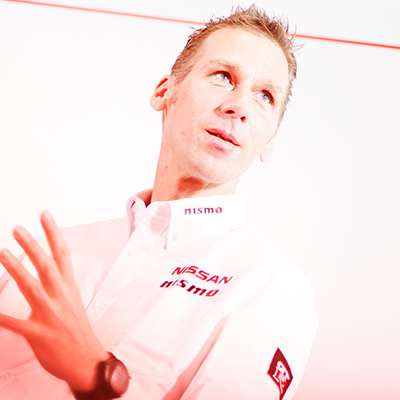


As a Nissan driver and a champion of the FIA GT1 World Championship, he competed at various races including SUPER GT and FIA GT for many years, contributing to Nissan winning numerous titles. Particularly, with his high development capabilities, he provided precious feedback to the engineers to help the team win. He recorded the fastest time for production vehicles at 7:08.679 with the NISSAN GT-R at Nurburgring. As the NISMO GT3 2018-Spec development driver, he participated in the project at its initial stage, significantly contributing to the evolution of the vehicle.






